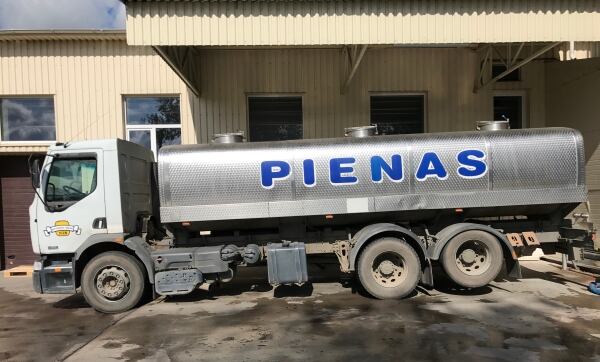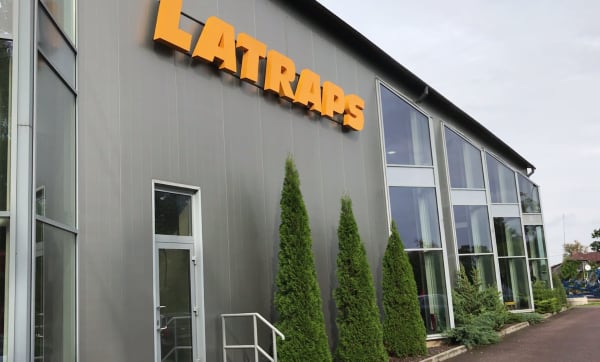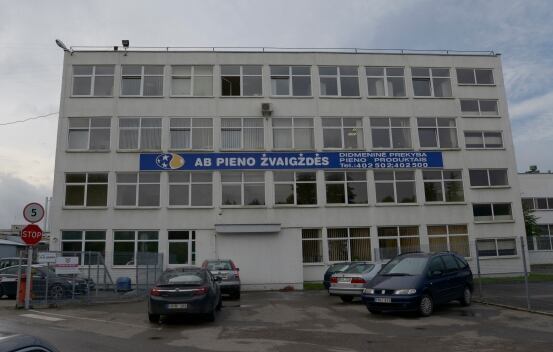The trip took in visits to companies in Lithuania, Latvia and Estonia.
Background
As the former Soviet Union disintegrated, 15 ‘new’ independent states were created, mostly in 1991.
Some had been states within the Soviet Union, others were ‘independent’ nations tightly controlled from Moscow.
For many, the freedom brought great excitement and opportunity, but also huge challenges.
In the dairy industry, for example, many companies and cooperatives in countries such as the Netherlands, Denmark and Italy have been in business for decades, even centuries, and so the newly-independent states, and their businesses, had to develop very quickly.
Closest market
Initially, most of these countries turned their attention to supplying the market they had been so closely tied to for many decades – Russia.
And while some nations still maintain those close ties, for others, the focus of future development was clearly by looking west.
However, it was more than a decade before eight of these countries – the Czech Republic, Hungary, Poland, Slovakia, Slovenia, Estonia, Latvia and Lithuania – joined the European Union in 2004.
Along with Malta and Cyprus, the European community jumped overnight to a group of 25 nations. It was the first growth of the EU since 1995, when Sweden, Finland and Austria became members.
In the decade after the 2004 growth, three more former communist countries – Bulgaria, Romania and Croatia – which had risen from what had been Yugoslavia – joined the EU.

Unique EU countries
Of the 11 countries that had been subject to communist rule, however, only three were actually former Soviet republics, the Baltic states of Estonia, Latvia and Lithuania.
While these nations certainly benefited greatly from membership of the European Union in terms of the ability to market their products to other Member States, for the Baltic countries and others bordering Russia such as Finland, sales to the world’s biggest nation still contributed greatly to the financial stability of their companies.
And none more so than dairy companies. Not only was there a market in Russia, transportation costs were much lower. As an example, Lithuanian dairy company Rokiskio Suris, which was recently in the news after an investment from New Zealand cooperative Fonterra, is 258km from Russia, yet 2,200km from Paris.
Russian embargo
However, the economics for the Baltic states were affected again – adversely – when, in response to sanctions on Russia following its invasion of the Crimean peninsula in Ukraine, Russia imposed a ban on imports from the EU.
The Baltic states were not the only ones hurt by the sanctions. Companies, such as Valio in Finland, were also affected, as were many dairy companies that had long enjoyed sales in the huge Russian market.
Indeed, at the 2016 eda summit, Valio’s Elli Siltala noted Valio’s sales dropped by 20% overnight. At that event, EC Minister for Agriculture and Rural Development, Phil Hogan, admitted that, before the embargo, 250,000 tons of cheese alone was headed to Russia.
While some of the losses have been replaced by sales to other markets, clearly tensions with Russia impact its closest geographical neighbors more acutely.
And Russia would seem to be a market closed to EU members for the foreseeable future.
Big countries, small populations
For the Baltic states, agricultural exports are essential. There is plenty of agricultural land and small populations, meaning the nations can easily feed the population with plenty to spare. This means the country and companies need to find markets to export their products.
Area/population comparison
Estonia 45,336 sqkm. Population 1.3m
Latvia 64,589 sqkm. Population 1.96m
Lithuania 65,300 sqkm. Population 2.87m
Pennsylvania 46,054 sqkm. Population 12.7m
Florida 65,757 sqkm. Population 20m
Indeed, driving around the nations for several days, it becomes clear agriculture is of huge importance, as huge swathes of the countries are dedicated to the agriculture industry.
But it didn’t start out that way.
Traveling around all three nations, there are stark contrasts. Huge, modern shopping malls sit close to dilapidated Soviet-era buildings.

Modern housing complexes look out over inhabited buildings that seem uninhabitable.
Visiting large cities such as Rīga and Kaunas, it’s interesting to see many businesses dedicated to repairs. Indeed, on visiting companies’ plants, those giving tours are as proud of the old machinery they’ve managed to keep working as they are of the modern equipment they have been able to acquire to improve efficiency.
It’s a part of that contrast, both the old and the new, and also representative of the struggles both before and after independence. Waste is not an option.
Difficult beginnings
One company, LATRAPS in Latvia, divested its dairy division to concentrate on agricultural crops such as grain and rapeseed oil (the company name, derives from Latvia and rapeseed).
A company spokesperson said initially in Latvia the agricultural situation was difficult after independence.
“There was no money,” he said.

From the big collective farms under Soviet control, previous owners, or their heirs, were being given back their land.
“Farmers started, but it was unprofessional,” he said.
“Land was being given back to teachers, etc. Some didn’t want the land. Some wanted to give it back to the country, and sell it back.”
And they were selling it back cheaply, although for what was, at the time, a good sum of money.
Huge growth
However, some farmers started to work the land and collaborated with neighbors, to get better prices on fertilizer and feed, and to sell products in larger quantities to make it worthwhile and to improve prices.
LATRAPS started with 12 members.
“We couldn’t grow enough grain for local consumption,” the spokesperson said of those first difficult, unproductive years.
Gradually, things improved as more land was turned back to agriculture and techniques improved.
“Then, after five or six years, there was too much. We had to think about export. But each year we have growth. It’s in turnover, the number of members, and yields are still growing. Now there are close to 1,000 members.”
‘Communist’ cooperatives
LATRAPS isn’t the only cooperative doing well.
In Estonia, Epiim is one of the top five dairy companies in the country. It’s also a cooperative.
And, not unlike in Latvia, those early days were a struggle.
As with LATRAPS, cooperatives also struggled to get off the ground in Estonia, Jaanus Murakas, chair of Epiim told DairyReporter.
“It was very interesting; all the companies in the beginning of the 90s were state-owned companies,” Murakas explained.
“And the state started to privatize factories and companies. Farmers were in a bad situation. There was no license to sell to the EU. But the farmers made new cooperatives.
“Just the banks or rich people were privatizing these kind of factories. Cooperatives could only take what was left. And only those in a very bad situation or with old technology.
“In the beginning of the 90s, public opinion was against cooperatives. City people assumed people doing something together, it was a symbol of something Soviet!”
Cooperative model
However, dairy cooperatives around the world were seen as a successful model, and in 1997, three cooperatives joined together.
They assumed they were so small they couldn’t go on, so joined together and became Epiim (E, for Estonia, piim being Estonian for milk).
Estonia actively promotes its dairy industry as having centuries of experience, and now the country is also looking to the future.
Epiim, the cooperative interviewed in the video for this feature, is expanding.
Estonia also has a dairy strategy running up to the year 2020. Epiim and Valio Eesti are among the members of the Eesti Piimaliit dairy association pushing the dairy sector forward.
The economics
Dairy prices paid to farmers in the region were the lowest in the EU as recently as last year, however, prices are rising faster than in some other EU countries. But that doesn’t mean all of the countries’ dairy industries are faring well.
Price of milk paid to farmers €/100kg, ranked according to price in the 25 EU countries:
EC Milk Market Observatory figures
Jan 2016
Estonia €23.43/$27.75 (23/25)
Latvia €22.00/$26.05 (25/25)
Lithuania €22.57/$26.73 (24/25)
Oct 2017
Estonia €33.97/$40.23 (14/25)
Latvia €32.04/37.95 (20/25)
Lithuania €33.46/39.64 (16/25)
Euromonitor International data shows Estonia’s dairy retail value stood at €195.6m ($231.7m) in 2011, which has grown to €242.3m($287m) in 2017. Year-on-year growth has also been healthy: 6.1% in 2012-13, and 3.9% in 2016-17.
Latvia, on the other hand, has seen only modest year-on-year growth. In 2012-13, it stood at 1.3%; in 2016-17 only 1.6%. However, sales were higher when compared to Estonia. In 2017, dairy retail value stood at €334.8m ($396.6m).
Lithuania, with a larger population and area, has the highest dairy retail value in 2017, at €442.9m ($524.6m). Its year-on-year growth, after a decline, has recovered to 3.9% in 2016-17.
Lithuania
According to an 2016 Enterprise Lithuania report, in 2015, the majority of exports of dairy products of Lithuanian origin headed for European Union countries, with a share of 76.7%.
Statistics Lithuania: top 5 companies 2015 turnover
JC Pieno Žvaigždės
JC Rokiškio Sūris
JC Žemaitijos pienas
JSC Marijampolės pieno konservai (see interview below)
JSC Vilkyškių pieninė
The most important export market was Italy, with a share of 19.2%, followed by Poland with 18.1% and Germany with 14.7%, Latvia with 8.4% and the US at 6.3%.
In 2015, the largest growth in exports was to the US with €14m ($16.6m), South Korea with €4.3m ($5.1m) and Uzbekistan with €4m ($4.7m).
The largest decreases were in Russia with €88.9m ($105.3m), Belarus with €17.7m ($21m) and Italy with €11m ($13m).

According to Euromonitor International’s country report, in 2016, Rokiškio Sūris led the cheese category with a retail value share of 26% in 2016; for milk Pieno Žvaigždės led with a retail value share of 31% in 2016, as well as in the yogurt category, with a retail value share of 24% in 2016.
Latvia
In Latvia, according to Euromonitor International, following a merger, Food Union held a combined 37% value share for cheese in 2016, the company also leads the milk and yogurt categories for local brands, with French company Danone the biggest player in yogurt.
According to the European Dairy Association EDA Dairy Focus 2015 figures, the top export markets for Latvian dairy products were Lithuania, Germany, Russia, Estonia and the Netherlands.
Estonia
The cheese category in Estonia in 2016, from Euromonitor International’s country report, shows Põltsamaa Meierei Juustutööstus in top spot with 33% value share in 2016.
In milk, Tere AS the leader with a 40% value share in 2016. It was followed by MAAG Piimatööstus with 21% and Valio Eesti AS with 20%. For yogurt, Tere AS led value sales in 2016 with a 33% share.
Estonian Dairy Association figures show the top five export markets are its neighbors: Latvia, Lithuania, Finland, Sweden and Russia.
Great potential
It’s interesting traveling around the Baltic countries and observing people. Those under the age of about 30 have known only independence – those older have varying degrees of memories of being an involuntary part of another country.
However, the general feeling is one of contentment and optimism. The people, for the most part, speak several languages, including English. They are friendly, helpful, proud, and have a belief that they are achieving good things and contributing to not only their own and Europe’s economies, but also the world.
And, as the economic figures above seem to show, at least in the dairy industry, there is the potential for real, and sustained, growth.
